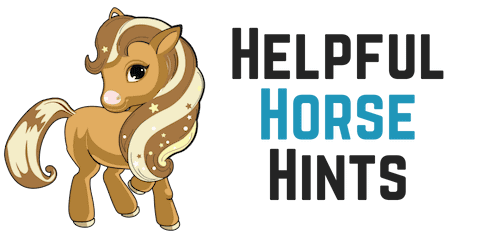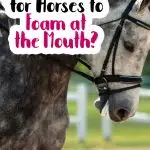Foamy mouth in horses might be from stress, but it’s often not harmful. It is important to note the excess salivation, but my best advice on what to do after that is to not panic as you consider the possible causes.
If you’ve ever attended a horse race, like the Kentucky Derby, you might have seen a foamy substance flying off the horses as they ran. At horse shows, such as Medieval Times, you’ll see foam on the horse’s lips when they’re ridden, as they literally “chomp at the bit”. The term ‘happy mouth‘ is used sometimes to describe this behavior, which indicates that the horse is accepting the bit and relaxing.
Eating can cause foamy mouth in horses because of normal salivary production, but also because of a special protein in horse sweat and saliva called latherin. This protein lathers up like soap when the horse is exerting itself and when the substance is churned up or rubbed.
However, some causes of foamy mouth in horses are bad. Oral ulcers or gum disease can indicate a problem in the mouth which is causing extra saliva production. A foamy mouth can also one caused by choke, a situation in which the horse has food stuck in its throat. This sounds bad, but it’s not that rare in horses, and they usually clear it on their own.
Those are the most common causes, but in order to bring you the most comprehensive list, we’ll present a full 15 possible causes for this you can work through. We’ll start by looking at latherin and why it’s special when it comes to foam.
Table of Contents
Key Takeaways
- Foamy mouth in horses is normal when the horse is relaxed and doing some work, but it should be monitored.
- The protein ‘latherin’ in horse saliva and sweat causes the foam, especially when the horse is active.
- While some causes of foamy mouth are benign (stress or normal exertion), others like oral ulcers or choke indicate potential health issues.
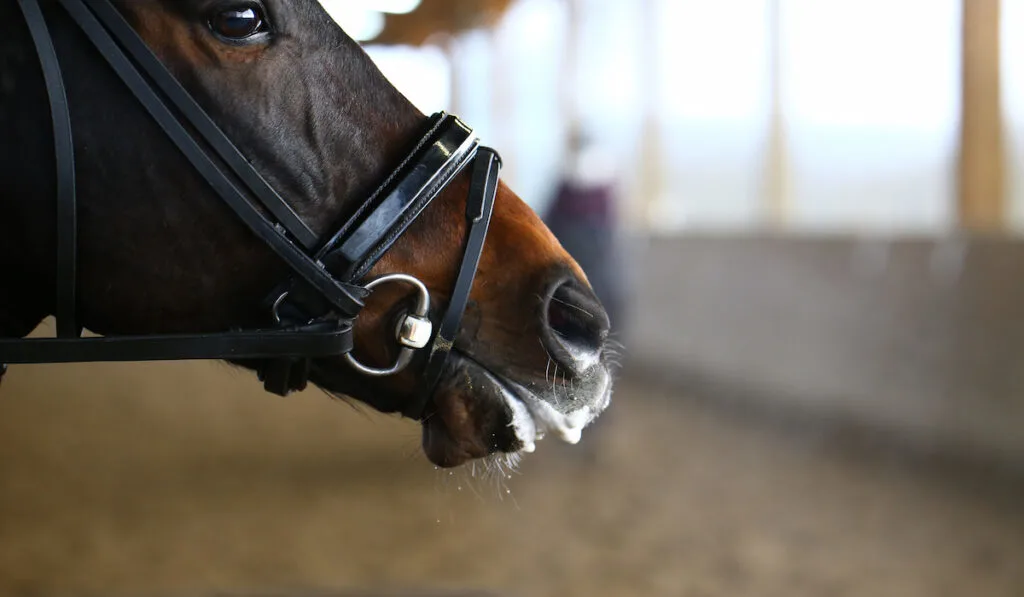
1. What’s the Foam Around A Horse’s Mouth? A Protein Called Latherin.
When a horse is working up a sweat, you can often see a thick “foam” coming from the animal’s mouth. It might also appear on the horse’s chest or around the saddle area. So what is it?
Horse sweat and saliva contain a protein-rich substance called latherin. This substance turns the sweat into a slippery, soap-like solution. This helps the sweat slide off the horse’s body and improves their thermoregulation (a horse’s heating and cooling system). Just like the proteins in eggs, when latherin is agitated, its proteins stretch out and tangle with each other. So, just like you can whip eggs into a meringue, the latherin can be whipped into a foam on the horse.
Latherin is also present in a horse’s saliva. It may help them easily digest large quantities of dry forage. When latherin is combined with friction or mixed with the air, it causes foam. This is why you may see foam on a horse’s mouth, or other parts of their bodies (especially around where a saddle or other tack is rubbing).
If you want to know more about this, I highly recommend you check out the video below, in which a charming Australian explains why a horse’s sweat has this special protein to counteract its natural waterproof coat.
2. Eating, drinking, and chewing.
Latherin may help horses eat and digest the vast quantities of dry food that they have to consume in a day. Imagine eating cereal all day long with no milk to wash it down!
Horses produce between 3 and 10 gallons of saliva a day. More than that is called “hypersalivation,” which is characterized by excess saliva production – your horse might be drooling and dribbling like a St. Bernard.
If you see your horse foaming at the mouth while he’s munching on his afternoon snack, it’s probably a normal part of the eating process. If the horse has other alarming symptoms such as changes in behavior, lethargy, blood in the saliva, or is just not acting like himself – call your veterinarian right away.
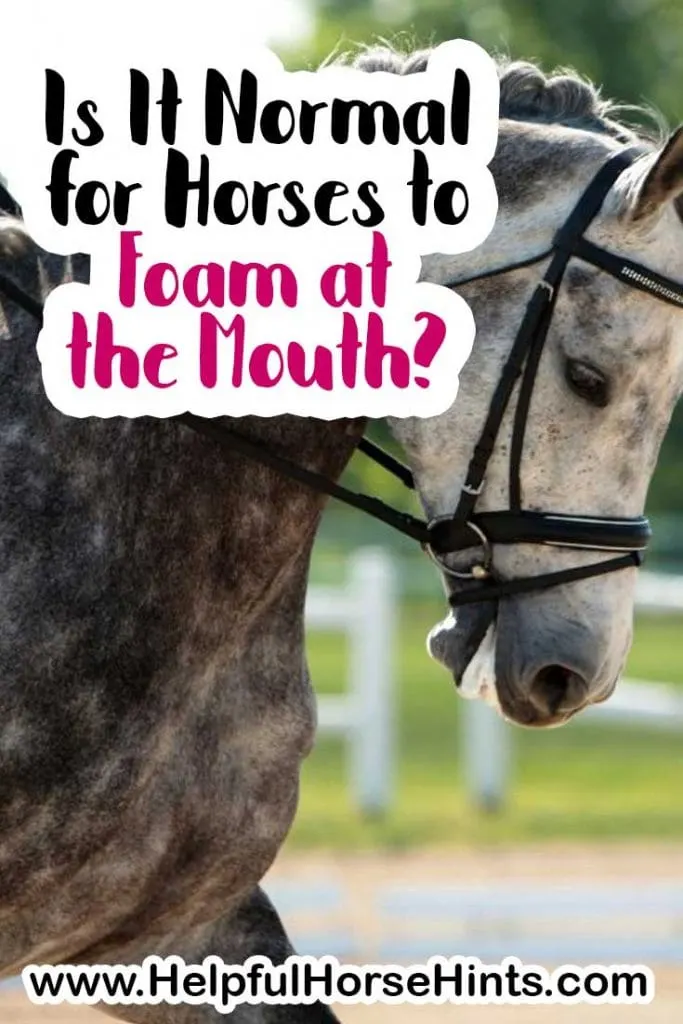
3. Bits are often to blame.
Most of the time, a foamy mouth on a working horse is caused by a bit.
A bit is a piece of metal that is attached to a bridle, and it fits in a horse’s mouth – resting over the tongue on gaps between teeth called “bars”. A bit in a horse’s mouth breaks the suction of their lips. The air mixes with their saliva – causing foam.
Horses produce saliva when actively chewing or licking. If a horse is chewing on the bit or playing with it, the excess saliva will often dribble from its mouth and churn up some frothy foam.
A bitless bridle may be a solution for a horse that foams too much when using a traditional bit. But in my experience, this is rarely an issue.
4. It can be a sign of relaxation.
Some people argue that foam is a good thing. Dressage enthusiasts look for “happy foam” – a foamy horse is a relaxed horse that is “on the bit” and engaging with the rider. A horse that is using its whole body with proper dressage form will also produce more saliva:
“That is because in true collection when the forehand pulls upward through the thoracic sling, an upward draw is also acted upon through the neck and into the poll. This upward/forward directionality is the mechanism that causes the horse to seek the bit, a staple of correct dressage.”
A horse with no foam around its lips may be tensing in the mouth, neck, or body. These are signs that perhaps something isn’t quite right.
Some riders will give their horses a bit of apple or a sugar cube before a competition to encourage the saliva to flow.
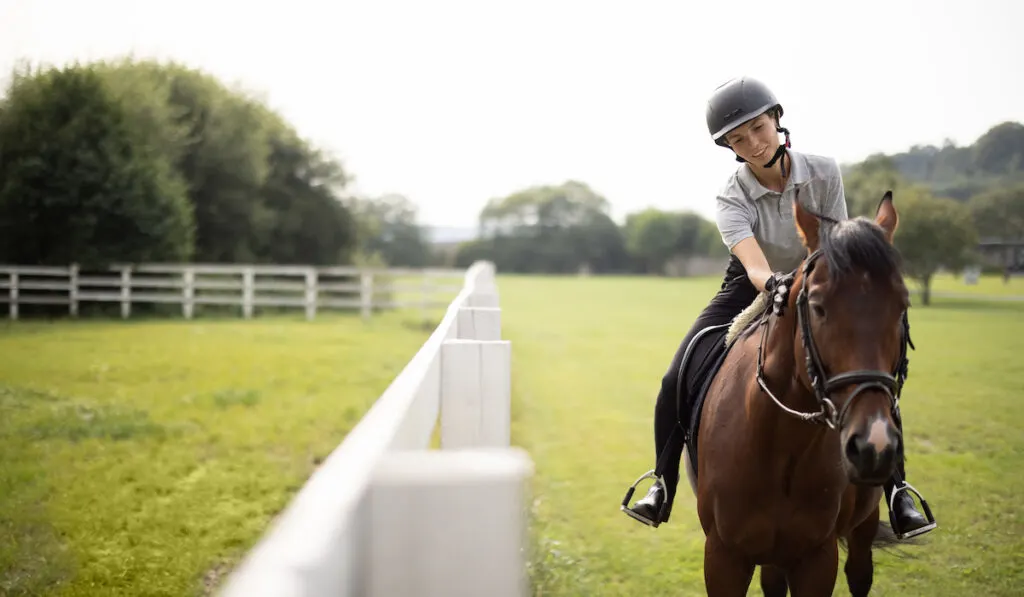
5. It can be a sign of stress or exertion.
A tense horse may also foam at the mouth. Excess saliva isn’t only caused by relaxation, but it can be a symptom of poor riding or overexertion. A horse that is overworked may produce foam because that’s the body’s mechanism for trying to cool itself down quickly – necessary for a flight animal.
However, every horse is different – some horses sweat a lot, some horses hardly sweat at all. Depending on the season and the work that is required, some horses may be more “foamy” than others.
This doesn’t necessarily indicate that the horse is overworked. If you notice that your horse is getting sweatier and giving you more slobbery kisses than usual, consider taking a break and evaluating your work plans.
If you see a horse at a competition, like Olympic Dressage, with red or pink-tinged foam, something has likely gone wrong. Red or pink foam means that there is likely blood present somewhere, and should be investigated.
6. Hard hands or poor riding form
A horse that is being ridden correctly should have no trouble swallowing to diminish the excess saliva. If a rider is holding his horse’s head too high or too tightly, it can force the horse’s jaws open. If a horse can’t close his mouth, it can’t swallow properly – and the foam will start flying.
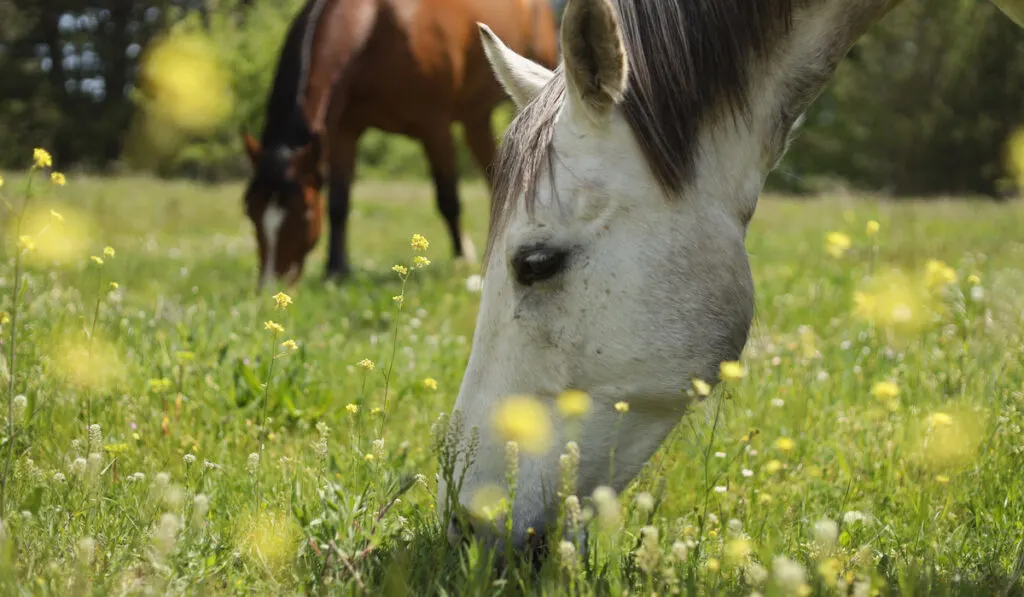
7. Clover slobbers
Sometimes, the foam has nothing to do with the equipment at all. Sometimes, a horse frolicking in the pasture will suddenly begin to drool excessively. In a field filled with clover, this is often an example of the fungus-induced “clover slobbers.”
The Rhizoctonia fungus lives on legumes – like red and white clover. Rhizoctonia contains slaframine, which causes horses to excessively salivate. But don’t worry, “the slobbers” aren’t usually harmful – just annoying to owners.
8. Choking, foreign body in the throat
Horses can get up to all sorts of shenanigans in the pasture, including eating things they shouldn’t. If your horse is acting strangely in the pasture, coughing and foaming at the mouth – they may have a stick or other foreign body lodged in their throat. If you think this is the case, call your veterinarian right away!
For a more thorough look at choking in horses, check out this post on the blog which includes video as well.
9. Mouth injury
Have you ever bitten your tongue or the inside of your cheek? If you’ve ever had a sore in your mouth, it can be hard to leave the injury alone.
Horses with injuries inside their mouths may be chewing or licking them, which causes the extra saliva to flow.
An excessively slobbery horse may also have mouth ulcers, which are caused by many different things. Certain plants, chemicals, or viruses can give a horse painful mouth blisters – so be on the lookout for other symptoms.
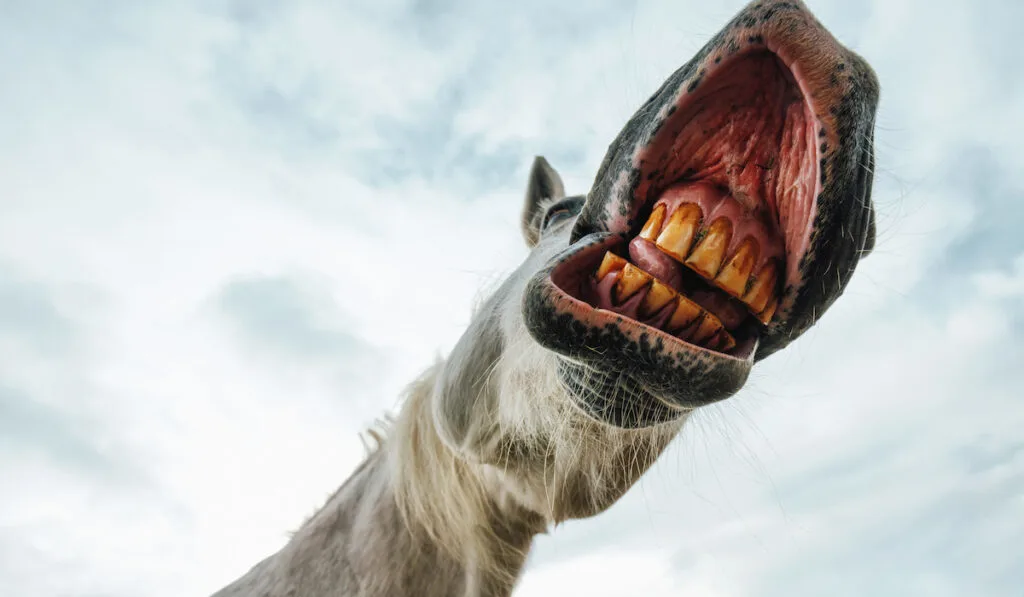
10. Dental injury or disease
Likewise, a sore tooth can be hard to ignore. Sometimes, dental issues are the culprit for horses with excessive drooling or foaming at the mouth:
- Plaque
- Loose teeth
- Tartar
- Gingivitis
- Bleeding gums
- Bone spurs
- Missing teeth
- Misaligned bite
Horses are adept at hiding their pain, so make sure your horse sees an equine dentist regularly.
11. Vesicular stomatitis
Vesicular stomatitis is a virus that causes blisters in or around a horse’s mouth, lips, or nose. It is rarely fatal, but horses suffering from this virus may have a fever, difficulty eating, lose weight, or become lame.
This disease also affects the hoof walls, but it shouldn’t be confused with the devastating “hoof and mouth” disease.
A blood test can identify vesicular stomatitis, and symptoms can be managed with soft food, plenty of rest (away from other animals!), fluids, and medication.
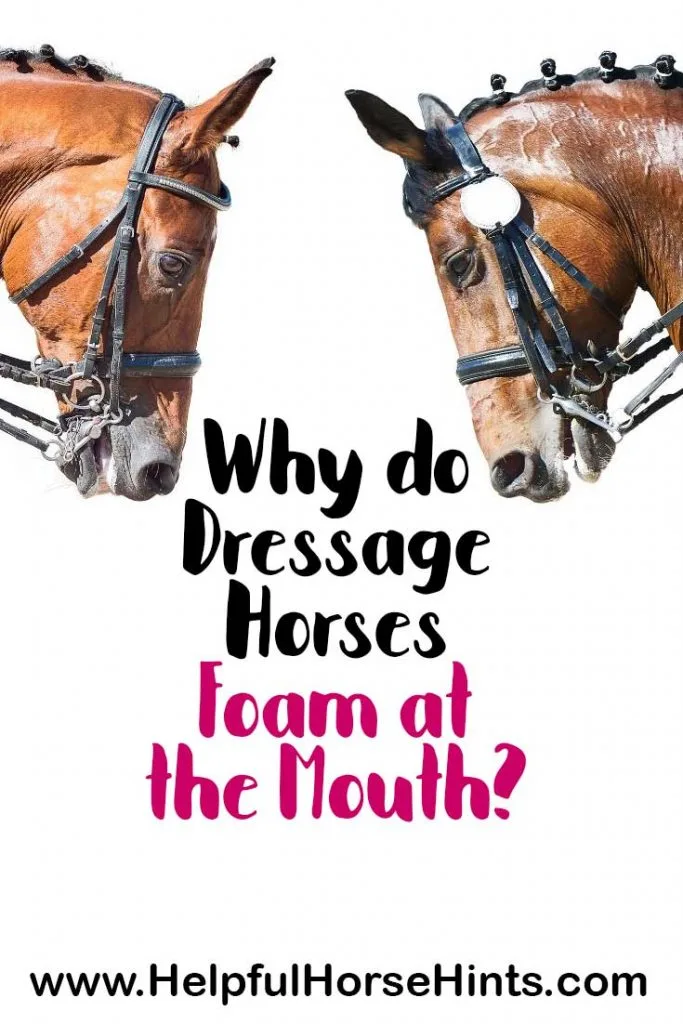
12. Rabies
Rabies is a fatal disease carried by skunks, foxes, bats, and raccoons. Because it’s transmitted through saliva, infected horses pose a great risk to humans and other animals.
Horses with rabies can exhibit a wide variety of symptoms, and individual cases may vary.
Luckily, the rabies vaccine is very effective in preventing rabies – and is considered a core vaccine by the American Association of Equine Practitioners. If your horse has been properly vaccinated against rabies, there’s probably nothing to worry about.
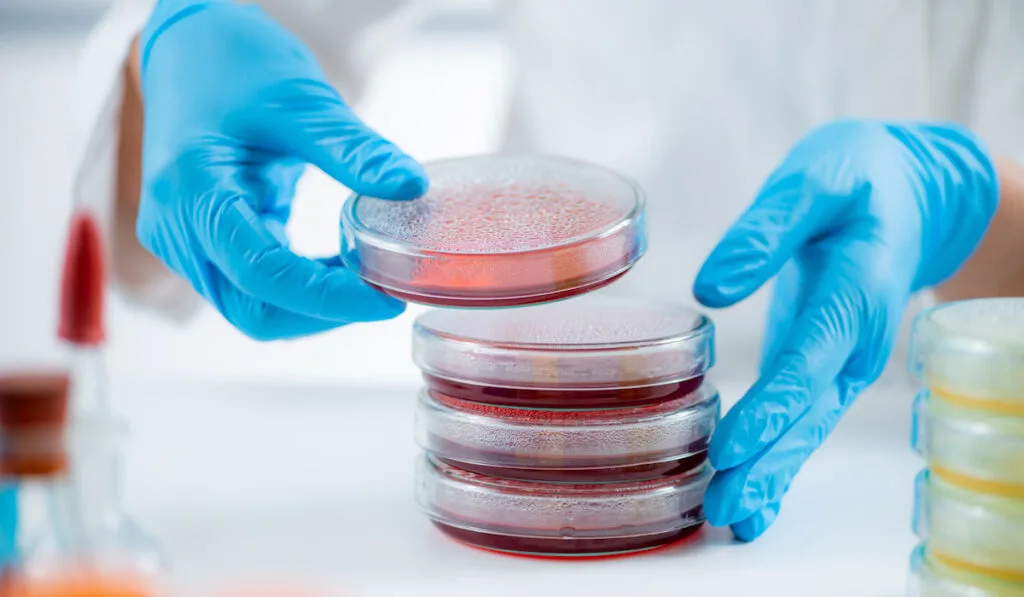
13. Bacteria
Excessive drooling may also be caused by bacteria. “Wooden tongue” is a condition that causes tumor-like abscesses on the tongue. Equine grass sickness is a mysterious disease mostly found in the United Kingdom and has been linked to a strain of botulism.
14. Toxic substances
Aside from infectious diseases, many different chemicals can cause hypersalivation in horses.
- Heavy metal toxicity: Fields or feed contaminated with heavy metals can cause serious health repercussions for horses over time. If you keep your horses at home, be sure to test your soil regularly, and replace old pipes or water troughs as needed.
- Organophosphate toxicity: The term “organophosphate” refers to a group of chemical compounds commonly used as pesticides. While generally not harmful in small doses, accidental poisoning of horses and other animals can occur if ingested in large quantities.
- Poison: Many chemicals, plants, and animals are poisonous to horses. If you suspect your horse may have gotten into something dangerous, call your veterinarian right away.
15. Other diseases that cause hypersalivation and foaming
If all the common causes have been ruled out, some uncommon diseases can cause a horse to send the spittle flying.
- Equine viral arteritis – often confused with other equine respiratory diseases, this virus can cause permanent damage to young horses and their offspring.
- Borna disease – This virus can cause paralysis and even death, and primarily affects horses and sheep.
Non-transmissible diseases:
- Musculoskeletal deformities (whether a horse was born with them or they’re a result of injury to the face or neck)
- Mouth deformities.
- Tongue deformities.
As you can see, there are many reasons why a horse may foam at the mouth. Most of them are harmless, but if your horse is avoiding food or exhibiting other odd behavior, call your veterinarian right away.
Related Posts
- Best Horse Breeds for Dressage
- Cribbing in Horses: What it is and how to stop it
- Horse Colic & Beer: 5 Things You Need to Know
